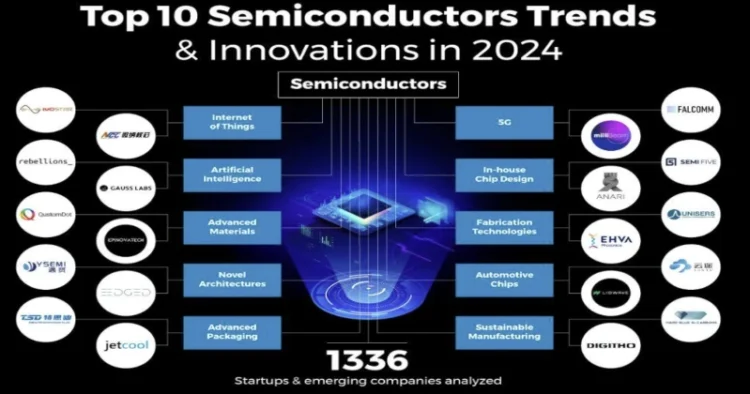Today, chip-making requires sophisticated, expensive, and highly polluting processes. It needs critical changes, from architectural design to sustainable materials and end-to-end fabrication to address the growing demand for semiconductors. To achieve this, the industry is adopting the latest technologies that increase efficiency and meet environmental requirements.
Top 10 Semiconductors Trends for 2024
1. Internet of Things
IoT devices press certain demands such as smaller sizes, diverse connectivity technologies, and lower power consumption. To address these requirements, semiconductor manufacturers focus on sensors and integrated circuit development. That is why startups are developing flexible multifunctional chipsets with increased circuits. They also combine microcontrollers and analytics into IoT to move computing to the source, making devices less vulnerable.
2. Artificial Intelligence
A rapid rise of AI solutions is forcing the chip industry to develop AI-ready hardware. Semiconductor companies also integrate AI into manufacturing workflows to optimise operations and improve product quality. That is why startups are offering hardware-based acceleration technologies that run neural networks. These advanced processors handle deep learning workloads and find applications across industries.
3. Advanced Materials
Beyond reducing structure size, semiconductor startups are pursuing “more than Moore” innovations by leveraging novel materials. They include silicon carbide (SiC) and gallium nitride (GaN) which feature a wider bandgap. This brings several advantages such as high voltage resistance, higher operating temperatures, faster switching, and a smaller form factor.
4. Novel Architectures
Due to the fierce competition for faster processing speeds, the chip industry is leveraging novel architectures. Startups build non-volatile memory chips, integrate heterogeneous 3D-enabled designs, and use nanotechnology to develop novel processor architectures.
5. Advanced Packaging
Electronic packaging technologies significantly affect chip power, performance, and cost. Advanced packaging solutions allow manufacturers to merge multiple components into a single electronic device with better signal connections.
6. 5G
The hardware requirement for 5G is a critical aspect in ensuring its market penetration and performance. Therefore, startups are developing tech-driven solutions to enable low-latency connectivity and reliability for indoor and outdoor networks. These 5G-oriented products include private networks, millimeter wave chipsets, and signal amplifiers, among others.
7. In-house Chip Design
Semiconductor companies are transitioning to in-house chip design for better control over their product roadmaps and supply chains. Customised chips with flexible architecture and reused components also enable producers to reduce development timelines. In-house chip design moves the industry from general universal processors to more customised hardware.
8. Fabrication Technologies
The continuous miniaturisation of chip geometries requires precise and detail-oriented fabrication technologies. It also brings challenges such as forming fine patterns and placing them on the die on the nanoscale. Metals implemented to reduce wiring delays in circuits add additional complexity.
9. Automotive Chips
Modern vehicles with autonomous driving capabilities have already altered demand patterns for automotive semiconductors. These vehicles require better electronic solutions for improved connectivity, enhanced sensors, battery performance, and more. That is why there is a growing demand for specialty HPC chips that support real-time and complex analytics.
10. Sustainable Manufacturing
To maintain the increasing interest in semiconductors and simultaneously meet the ecological requirements, manufacturers are scrutinising emissions along the entire supply chain. Chip fabrication generates massive amounts of emissions due to manufacturing tools, chemicals, raw materials, and extensive subfab facilities. Therefore, chip manufacturers are switching to alternative fuels such as biogas and green hydrogen to ensure sustainable operations.
Impact of the Top 10 Semiconductor Industry Trends
The Tree Map below illustrates the impact of the Top 10 Semiconductors Trends and Innovations in 2024. Startups and scaleups are developing application-specific integrated circuits (ASICs) to accommodate IoT, AI, and 5G. They bring economical value and enhance manufacturing capabilities. Additionally, automotive chips provide high-quality sensors to ensure safe driving experiences. Further, businesses are transitioning to in-house design for personalised chip design. Novel architectures ensure better performance by scaling capacity through multi-component integration and direct-to-chip interfacing. Sustainable manufacturing efforts allow semiconductor businesses to achieve a balance between rapid innovation and ecological considerations.

The semiconductor industry is integrating digital tools, fabrication technologies as well as novelties in materials and design. Further, more and more companies are integrating in-house chip production to address the chip shortage. This will drive innovation towards easily scalable and deployable fabrication units. Future innovations will also make personalised chips even more accessible while making chip production more efficient and, importantly, sustainable.




















Comments